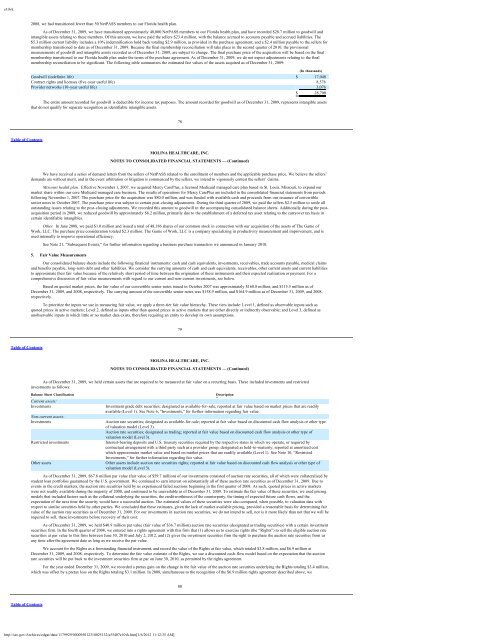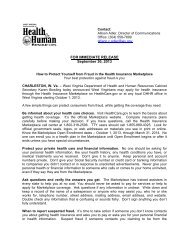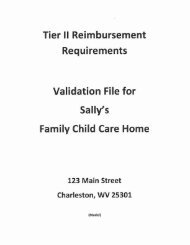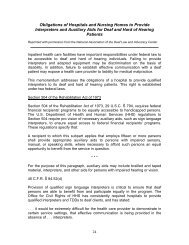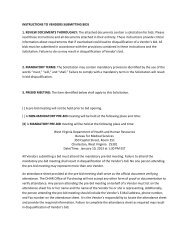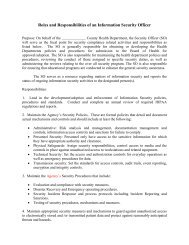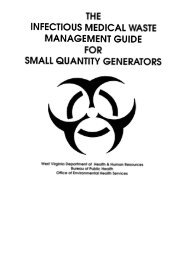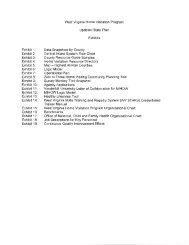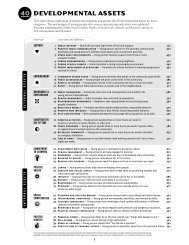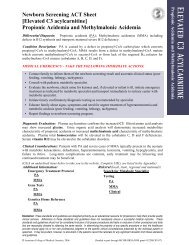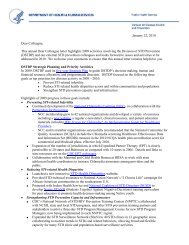Molina Medicaid Solutions - DHHR
Molina Medicaid Solutions - DHHR
Molina Medicaid Solutions - DHHR
You also want an ePaper? Increase the reach of your titles
YUMPU automatically turns print PDFs into web optimized ePapers that Google loves.
e10vk2008, we had transitioned fewer than 50 NetPASS members to our Florida health plan.As of December 31, 2009, we have transitioned approximately 48,000 NetPASS members to our Florida health plan, and have recorded $28.7 million to goodwill andintangible assets relating to these members. Of this amount, we have paid the sellers $23.4 million, with the balance accrued to accounts payable and accrued liabilities. The$5.3 million current liability includes a 10% indemnification hold back totaling $2.9 million, as provided in the purchase agreement, and a $2.4 million payable to the sellers formembership transitioned to date as of December 31, 2009. Because the final membership reconciliation will take place in the second quarter of 2010, the provisionalmeasurements of goodwill and intangible assets recorded as of December 31, 2009, are subject to change. The final purchase price of the acquisition will be based on the finalmembership transitioned to our Florida health plan under the terms of the purchase agreement. As of December 31, 2009, we do not expect adjustments relating to the finalmembership reconciliation to be significant. The following table summarizes the estimated fair values of the assets acquired as of December 31, 2009:(In thousands)Goodwill (indefinite life) $ 17,048Contract rights and licenses (five-year useful life) 8,576Provider networks (10-year useful life) 3,076$ 28,700The entire amount recorded for goodwill is deductible for income tax purposes. The amount recorded for goodwill as of December 31, 2009, represents intangible assetsthat do not qualify for separate recognition as identifiable intangible assets.78Table of ContentsMOLINA HEALTHCARE, INC.NOTES TO CONSOLIDATED FINANCIAL STATEMENTS — (Continued)We have received a series of demand letters from the sellers of NetPASS related to the enrollment of members and the applicable purchase price. We believe the sellers’demands are without merit, and in the event arbitration or litigation is commenced by the sellers, we intend to vigorously contest the sellers’ claims.Missouri health plan. Effective November 1, 2007, we acquired Mercy CarePlus, a licensed <strong>Medicaid</strong> managed care plan based in St. Louis, Missouri, to expand ourmarket share within our core <strong>Medicaid</strong> managed care business. The results of operations for Mercy CarePlus are included in the consolidated financial statements from periodsfollowing November 1, 2007. The purchase price for the acquisition was $80.0 million, and was funded with available cash and proceeds from our issuance of convertiblesenior notes in October 2007. The purchase price was subject to certain post-closing adjustments. During the third quarter of 2009, we paid the sellers $2.5 million to settle alloutstanding issues relating to the post-closing adjustments. We recorded this amount to goodwill in the accompanying consolidated balance sheets. Additionally during the postacquisitionperiod in 2008, we reduced goodwill by approximately $6.2 million, primarily due to the establishment of a deferred tax asset relating to the carryover tax basis incertain identifiable intangibles.Other. In June 2008, we paid $1.0 million and issued a total of 48,186 shares of our common stock in connection with our acquisition of the assets of The Game ofWork, LLC. The purchase price consideration totaled $2.3 million. The Game of Work, LLC is a company specializing in productivity measurement and improvement, and isused internally to improve operational efficiency.See Note 21, “Subsequent Events,” for further information regarding a business purchase transaction we announced in January 2010.5. Fair Value MeasurementsOur consolidated balance sheets include the following financial instruments: cash and cash equivalents, investments, receivables, trade accounts payable, medical claimsand benefits payable, long-term debt and other liabilities. We consider the carrying amounts of cash and cash equivalents, receivables, other current assets and current liabilitiesto approximate their fair value because of the relatively short period of time between the origination of these instruments and their expected realization or payment. For acomprehensive discussion of fair value measurements with regard to our current and non-current investments, see below.Based on quoted market prices, the fair value of our convertible senior notes issued in October 2007 was approximately $160.8 million, and $115.5 million as ofDecember 31, 2009, and 2008, respectively. The carrying amount of the convertible senior notes was $158.9 million, and $164.9 million as of December 31, 2009, and 2008,respectively.To prioritize the inputs we use in measuring fair value, we apply a three-tier fair value hierarchy. These tiers include: Level 1, defined as observable inputs such asquoted prices in active markets; Level 2, defined as inputs other than quoted prices in active markets that are either directly or indirectly observable; and Level 3, defined asunobservable inputs in which little or no market data exists, therefore requiring an entity to develop its own assumptions.79Table of ContentsMOLINA HEALTHCARE, INC.NOTES TO CONSOLIDATED FINANCIAL STATEMENTS — (Continued)As of December 31, 2009, we held certain assets that are required to be measured at fair value on a recurring basis. These included investments and restrictedinvestments as follows:Balance Sheet Classification DescriptionCurrent assets:InvestmentsNon-current assets:InvestmentsRestricted investmentsOther assetsInvestment grade debt securities; designated as available-for-sale; reported at fair value based on market prices that are readilyavailable (Level 1). See Note 6, “Investments,” for further information regarding fair value.Auction rate securities; designated as available-for-sale; reported at fair value based on discounted cash flow analysis or other typeof valuation model (Level 3).Auction rate securities; designated as trading; reported at fair value based on discounted cash flow analysis or other type ofvaluation model (Level 3).Interest-bearing deposits and U.S. treasury securities required by the respective states in which we operate, or required bycontractual arrangement with a third party such as a provider group; designated as held-to-maturity; reported at amortized costwhich approximates market value and based on market prices that are readily available (Level 1). See Note 10, “RestrictedInvestments,” for further information regarding fair value.Other assets include auction rate securities rights; reported at fair value based on discounted cash flow analysis or other type ofvaluation model (Level 3).As of December 31, 2009, $67.8 million par value (fair value of $59.7 million) of our investments consisted of auction rate securities, all of which were collateralized bystudent loan portfolios guaranteed by the U.S. government. We continued to earn interest on substantially all of these auction rate securities as of December 31, 2009. Due toevents in the credit markets, the auction rate securities held by us experienced failed auctions beginning in the first quarter of 2008. As such, quoted prices in active marketswere not readily available during the majority of 2008, and continued to be unavailable as of December 31, 2009. To estimate the fair value of these securities, we used pricingmodels that included factors such as the collateral underlying the securities, the creditworthiness of the counterparty, the timing of expected future cash flows, and theexpectation of the next time the security would have a successful auction. The estimated values of these securities were also compared, when possible, to valuation data withrespect to similar securities held by other parties. We concluded that these estimates, given the lack of market available pricing, provided a reasonable basis for determining fairvalue of the auction rate securities as of December 31, 2009. For our investments in auction rate securities, we do not intend to sell, nor is it more likely than not that we will berequired to sell, these investments before recovery of their cost.As of December 31, 2009, we held $40.9 million par value (fair value of $36.7 million) auction rate securities (designated as trading securities) with a certain investmentsecurities firm. In the fourth quarter of 2008, we entered into a rights agreement with this firm that (1) allows us to exercise rights (the “Rights”) to sell the eligible auction ratesecurities at par value to this firm between June 30, 2010 and July 2, 2012, and (2) gives the investment securities firm the right to purchase the auction rate securities from usany time after the agreement date as long as we receive the par value.We account for the Rights as a freestanding financial instrument, and record the value of the Rights at fair value, which totaled $3.8 million, and $6.9 million atDecember 31, 2009, and 2008, respectively. To determine the fair value estimate of the Rights, we use a discounted cash-flow model based on the expectation that the auctionrate securities will be put back to the investment securities firm at par on June 30, 2010, as permitted by the rights agreement.For the year ended December 31, 2009, we recorded a pretax gain on the change in the fair value of the auction rate securities underlying the Rights totaling $3.4 million,which was offset by a pretax loss on the Rights totaling $3.1 million. In 2008, simultaneous to the recognition of the $6.9 million rights agreement described above, we80Table of Contentshttp://sec.gov/Archives/edgar/data/1179929/000095012310025132/a55407e10vk.htm[1/6/2012 11:12:35 AM]


